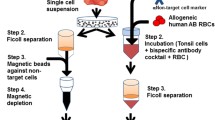Abstract
Metastasizing tumour cells from a DBA/2 mouse T-cell lymphoma could be separated from the invaded tissue by isopycnic centrifugation in continuous Percoll density gradients. The metastasizing tumour cells from spleen, liver and lung, derived from a cloned lymphoma-cell line, showed a buoyant density in Percoll of 1.060 +/- 0.010. They could be separated from the host tissue, which had a higher buoyant density in the case of the spleen cells or a lower density in the case of the dead liver or lung tissue. The separated tumour cells as removed from the gradients were viable, and could be analysed by in vitro and in vivo assays. The separation procedure did not affect the expression by the tumour cells of TATAs and H-2 antigens. Furthermore, the method seemed to be applicable to the separation of human tumour cells from mononuclear cells prepared from blood samples of tumour patients by Ficoll centrifugation.
Similar content being viewed by others
Rights and permissions
About this article
Cite this article
Bosslet, K., Ruffmann, R., Altevogt, P. et al. A rapid method for the isolation of metastasizing tumour cells from internal organs with the help of isopycnic density-gradient centrifugation in Percoll. Br J Cancer 44, 356–362 (1981). https://doi.org/10.1038/bjc.1981.192
Issue Date:
DOI: https://doi.org/10.1038/bjc.1981.192
- Springer Nature Limited
This article is cited by
-
Efficient and reliable establishment of lymphoblastoid cell lines by Epstein-Barr virus transformation from a limited amount of peripheral blood
Scientific Reports (2017)
-
Dynamic heterogeneity: isolation of murine tumor cell populations enriched for metastatic variants and quantification of the unstable expression of the phenotype
Clinical & Experimental Metastasis (1986)
-
Assay for the determination of human carcinoma cells in circulating blood
Journal of Cancer Research and Clinical Oncology (1985)
-
Purity and transplantation properties of tumor cell suspensions
Clinical & Experimental Metastasis (1985)
-
Antigenic variation in cancer metastasis: immune escape versus immune control
Cancer and Metastasis Review (1982)




